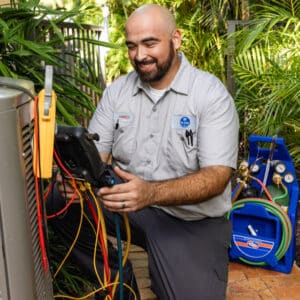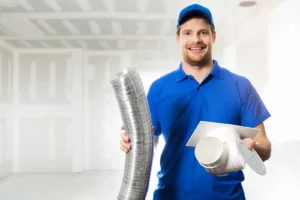When Is It Time to Replace an Aging AC System?
Air conditioning is essential for comfort in Florida’s hot and...
Living in Florida comes with a unique set of challenges, from heat and humidity to allergens and airborne pollutants. Since we spend a lot of time indoors to escape the weather, it’s important to know the air quality inside our homes. Clean indoor air isn’t just a matter of comfort; it directly impacts your health, energy levels, and well-being. Fortunately, there are ways to test and monitor air quality to ensure your home is as safe and healthy as possible.
Before diving into testing methods, it helps to understand the common indoor pollutants in Florida. High humidity can lead to mold and mildew growth, while pollen from the outdoors easily makes its way inside. Dust mites thrive in warm climates, and pet dander often adds to the mix. Volatile organic compounds (VOCs) from cleaning products, paint, or new furniture can also be culprits. Finally, poor ventilation may trap pollutants like carbon dioxide or even carbon monoxide, which can have serious health consequences.
Mold is a frequent concern for Florida homeowners due to the humid climate. To test for mold, you can purchase a mold testing kit from a local hardware store. These kits often involve taking samples from air vents or visibly moldy areas, then sending them to a lab for analysis. It’s not a foolproof method, but it can give you an idea of whether mold is a problem. If you suspect extensive mold growth, consider hiring a professional for a comprehensive inspection.
For allergens like dust mites and pollen, you can invest in an indoor air quality monitor that detects particulate matter. These devices provide real-time readings and alert you when levels are higher than usual. Keep an eye on these numbers, especially after activities like vacuuming or when windows are open on high-pollen days.
Volatile organic compounds are invisible and often odorless, but they can irritate your respiratory system or even cause long-term health problems. VOC monitors measure gases in the air, giving you an idea of how much pollution is present. If you notice a spike, it might be time to ventilate your home by opening windows or using exhaust fans. Additionally, consider switching to natural or low-VOC products for cleaning and maintenance.
Florida’s humidity is legendary, but keeping your indoor humidity in check is critical for comfort and health. High humidity levels (above 60%) can promote mold growth, while very low levels can irritate your respiratory system. A hygrometer is a simple tool that measures humidity, and many modern thermostats include this feature. If humidity is an issue, a dehumidifier or a properly maintained air conditioning system can make a world of difference.
Carbon monoxide (CO) is a dangerous gas that can be produced by faulty appliances like stoves, heaters, or fireplaces. It’s odorless and colorless, making it impossible to detect without a CO detector. Every home in Florida should have carbon monoxide detectors installed in key areas, especially near sleeping quarters. Regularly test these detectors and replace batteries as needed. If your home has an attached garage, make sure there’s no chance for car fumes to seep inside.
Poor ventilation can trap pollutants inside, degrading air quality. Your HVAC system should circulate fresh air while filtering out contaminants. To see how well your ventilation system is working, consider having it inspected. Check air filters monthly and change them as needed, usually every one to three months. If you use a higher-efficiency filter, follow the manufacturer’s guidelines. Dirty or clogged filters make your system work harder and reduce air quality.
Ceiling fans are another tool for improving ventilation. They don’t clean the air, but they help circulate it, preventing stale air from settling. Ensure your fans are spinning in the correct direction—counterclockwise during warmer months to push air downward.
Air quality monitors vary widely in terms of what they detect and their accuracy. Some models measure only particulate matter, while others include readings for VOCs, carbon dioxide, and humidity. Choose a monitor that suits your needs and budget. Basic models can be useful, but if you want a more detailed analysis, it’s worth investing in a higher-end monitor. Many of these devices connect to smartphones, making it easy to track trends and adjust your habits accordingly.
Once you’ve identified any issues, take steps to improve your indoor air quality. Use exhaust fans when cooking or showering to reduce humidity and odors. Invest in air purifiers for rooms where you spend the most time, like the bedroom and living room. Houseplants are another natural way to clean the air, although they’re not a complete solution. Be mindful of what you bring into your home; for example, air out new furniture or carpets before bringing them indoors.
Regular cleaning is also essential. Vacuum frequently using a HEPA filter, and dust surfaces to minimize allergens. Wash bedding in hot water to kill dust mites, and don’t forget about cleaning behind furniture or under beds, where dust collects. If you have pets, bathe and groom them regularly to reduce dander.
Regularly monitoring your indoor air quality is not something to do just once. Make it part of your routine to check your air quality monitors, change out filters, and look for signs of mold or other problems. Consistent attention to these tasks ensures that your home maintains the cleanest air possible.
By taking these steps to regularly test and track your indoor air quality, you’ll see a positive effect on both your health and comfort. While Florida’s climate presents unique challenges, the right tools and habits will help you create a healthier indoor environment. Keep being proactive, and you’ll enjoy cleaner air, better health, and greater peace of mind throughout the year.

Air conditioning is essential for comfort in Florida’s hot and...

Florida is known for its warm, humid climate, but even...

Florida homeowners rely on air conditioning more than most parts...

Indoor air quality is a major concern for many Florida...

Indoor air quality, often abbreviated as IAQ, plays a crucial...

Installing a new HVAC system is a significant investment in...